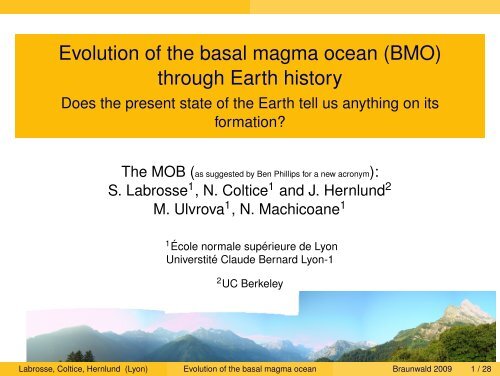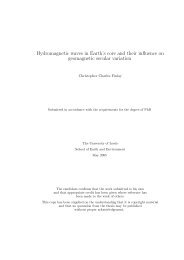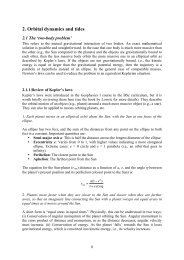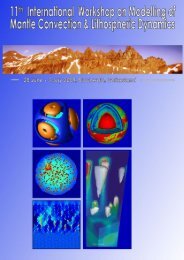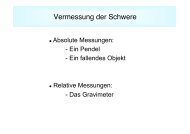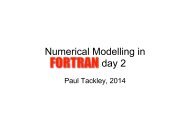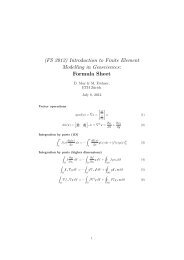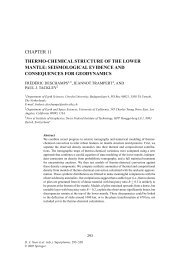Evolution of the basal magma ocean (BMO) through Earth history ...
Evolution of the basal magma ocean (BMO) through Earth history ...
Evolution of the basal magma ocean (BMO) through Earth history ...
You also want an ePaper? Increase the reach of your titles
YUMPU automatically turns print PDFs into web optimized ePapers that Google loves.
<strong>Evolution</strong> <strong>of</strong> <strong>the</strong> <strong>basal</strong> <strong>magma</strong> <strong>ocean</strong> (<strong>BMO</strong>)<br />
<strong>through</strong> <strong>Earth</strong> <strong>history</strong><br />
Does <strong>the</strong> present state <strong>of</strong> <strong>the</strong> <strong>Earth</strong> tell us anything on its<br />
formation<br />
The MOB (as suggested by Ben Phillips for a new acronym):<br />
S. Labrosse 1 , N. Coltice 1 and J. Hernlund 2<br />
M. Ulvrova 1 , N. Machicoane 1<br />
1 École normale supérieure de Lyon<br />
Universtité Claude Bernard Lyon-1<br />
2 UC Berkeley<br />
Labrosse, Coltice, Hernlund (Lyon) <strong>Evolution</strong> <strong>of</strong> <strong>the</strong> <strong>basal</strong> <strong>magma</strong> <strong>ocean</strong> Braunwald 2009 1 / 28
Introduction<br />
Our views on <strong>the</strong> lowermost mantle have largely changed over <strong>the</strong> last<br />
∼12 years:<br />
◮ Discovery <strong>of</strong> <strong>the</strong> ULVZ (Garnero & Helmberger ∼1996).<br />
◮ Recognition <strong>of</strong> dense <strong>the</strong>rmo-chemical piles (∼1999).<br />
◮ Discovery <strong>of</strong> <strong>the</strong> post-perovskite (Murakami, et al. 2004).<br />
What are <strong>the</strong> implications for <strong>the</strong> evolution <strong>of</strong> <strong>the</strong> deep <strong>Earth</strong><br />
ULVZ detection (SPdKS):<br />
Detected<br />
Not detected<br />
Unsampled<br />
Courtesy <strong>of</strong> S. Rost (2008)<br />
High res. detection<br />
(ScP, PcP, ScS):<br />
Detected<br />
Not detected<br />
(Murakami et al, 2004)<br />
Labrosse, Coltice, Hernlund (Lyon) <strong>Evolution</strong> <strong>of</strong> <strong>the</strong> <strong>basal</strong> <strong>magma</strong> <strong>ocean</strong> Braunwald 2009 2 / 28
ULVZ=melt<br />
Global tomography and ULVZ<br />
◮ Large V S anomalies in <strong>the</strong> lower mantle → <strong>the</strong>rmal and chemical<br />
heterogeneity.<br />
◮ ULVZs at <strong>the</strong> edges <strong>of</strong> dense <strong>the</strong>rmo-chemical piles.<br />
ULVZ detection (SPdKS):<br />
Detected<br />
Not detected<br />
Unsampled<br />
shear velocity variation from 1−D<br />
−1.4% +1.4%<br />
−1.4 −0.7 0.0 0.7 1.4<br />
S20RTS<br />
Ritsema et al. [1999]<br />
Depth= 2850 km<br />
Courtesy <strong>of</strong> S. Rost (2008)<br />
High res. detection<br />
(ScP, PcP, ScS):<br />
Detected<br />
Not detected<br />
Labrosse, Coltice, Hernlund (Lyon) <strong>Evolution</strong> <strong>of</strong> <strong>the</strong> <strong>basal</strong> <strong>magma</strong> <strong>ocean</strong> Braunwald 2009 3 / 28
ULVZ=melt<br />
Physical properties <strong>of</strong> <strong>the</strong> ULVZ<br />
Evidences for dense partial melt<br />
(Rost et al, 2005)<br />
Best fit<br />
Inversion<br />
parameters:<br />
◮ α = δV P<br />
◮ β = δV S<br />
◮ D = ULVZ<br />
thickness<br />
◮ ρ = ULVZ<br />
density<br />
(Rost et al, 2005)<br />
ULVZ thickness (km)<br />
Labrosse, Coltice, Hernlund (Lyon) <strong>Evolution</strong> <strong>of</strong> <strong>the</strong> <strong>basal</strong> <strong>magma</strong> <strong>ocean</strong> Braunwald 2009 4 / 28
ULVZ=melt<br />
The double crossing model<br />
Hernlund et al (2005), Nature.<br />
◮ Double seismic discontinuities explained if<br />
◮ <strong>the</strong> core temperature is high enough,<br />
◮ <strong>the</strong> temperature gradient is larger than <strong>the</strong><br />
Clapeyron slope.<br />
◮ Important geophysical implications<br />
◮ Direct measure <strong>of</strong> <strong>the</strong> <strong>the</strong>rmal structure <strong>of</strong><br />
<strong>the</strong> lower mantle.<br />
◮ Estimate <strong>of</strong> heat flux from <strong>the</strong> core 7–15 TW.<br />
⇒ Core cooling over <strong>the</strong> age <strong>of</strong> <strong>the</strong> <strong>Earth</strong>:<br />
∆T ∼ Q CMB∆t<br />
MC p<br />
∼ 1000K .<br />
Labrosse, Coltice, Hernlund (Lyon) <strong>Evolution</strong> <strong>of</strong> <strong>the</strong> <strong>basal</strong> <strong>magma</strong> <strong>ocean</strong> Braunwald 2009 5 / 28
ULVZ=melt<br />
Ideas on melt processes<br />
L<br />
Temperature<br />
S+L<br />
Time<br />
S<br />
(Mg,Fe)SiO 3 CaSiO 3<br />
<strong>Earth</strong> Eutectic<br />
Temperature<br />
Time<br />
L<br />
S+L<br />
S<br />
◮ For chemically complex systems, <strong>the</strong><br />
composition <strong>of</strong> liquid and solid are<br />
different.<br />
◮ In particular: Fe partitions<br />
preferentially in <strong>the</strong> liquid silicate<br />
ra<strong>the</strong>r than solid.<br />
◮ Density change on melting:<br />
∆ρ = ∆ρ φ + ∆ρ χ .<br />
◮ ∆ρ φ decreases with pressure<br />
◮ ∆ρχ < 0<br />
MgSiO 3 FeSiO 3<br />
<strong>Earth</strong><br />
Labrosse, Coltice, Hernlund (Lyon) <strong>Evolution</strong> <strong>of</strong> <strong>the</strong> <strong>basal</strong> <strong>magma</strong> <strong>ocean</strong> Braunwald 2009 6 / 28
ULVZ=melt<br />
Density cross-over in <strong>the</strong> lower mantle<br />
Ohtani (1983) :<br />
(Ohtani, 1983)<br />
◮ Densities extrapolated<br />
from upper mantle<br />
values.<br />
◮ Melt enrichment in FeO<br />
⇒ denser than solid.<br />
Labrosse, Coltice, Hernlund (Lyon) <strong>Evolution</strong> <strong>of</strong> <strong>the</strong> <strong>basal</strong> <strong>magma</strong> <strong>ocean</strong> Braunwald 2009 7 / 28
ULVZ=melt<br />
Shock experiments: Density<br />
MgSiO 3 Mg 2 SiO 4<br />
(Mosenfelder et al, 2009)<br />
◮ At high pressure, <strong>the</strong> volume change upon melting is small<br />
(MgSiO 3 ) or even negative (Mg 2 SiO 4 ).<br />
◮ Partitioning <strong>of</strong> Fe in <strong>the</strong> melt ⇒ Liquid denser than solid with a<br />
realistic composition.<br />
Labrosse, Coltice, Hernlund (Lyon) <strong>Evolution</strong> <strong>of</strong> <strong>the</strong> <strong>basal</strong> <strong>magma</strong> <strong>ocean</strong> Braunwald 2009 8 / 28
ULVZ=melt<br />
Shock experiments: Grüneisen parameter<br />
MgSiO 3 Mg 2 SiO 4<br />
(Mosenfelder et al, 2009)<br />
◮ High Grüneisen parameter γ ⇒ Crystallisation <strong>of</strong> <strong>the</strong> <strong>magma</strong><br />
<strong>ocean</strong> from <strong>the</strong> centre <strong>of</strong> <strong>the</strong> mantle.<br />
∂T ad<br />
∂P<br />
= γT ad<br />
K S<br />
Labrosse, Coltice, Hernlund (Lyon) <strong>Evolution</strong> <strong>of</strong> <strong>the</strong> <strong>basal</strong> <strong>magma</strong> <strong>ocean</strong> Braunwald 2009 9 / 28
ULVZ=melt<br />
Arguments for a hot start in <strong>Earth</strong> <strong>history</strong><br />
◮ Gravitational energy from <strong>Earth</strong> formation<br />
◮ Large impacts<br />
◮ Core segregation<br />
⇒ Enough energy to raise <strong>the</strong> average temperature by a few 1000<br />
K. A large amount <strong>of</strong> melting!<br />
◮ Runaway process: Iron<br />
melting → segregation →<br />
more melting (Ricard et al, in<br />
press, see movie <strong>of</strong><br />
temperature).<br />
◮ Partitioning <strong>of</strong> energy between<br />
<strong>the</strong> core and <strong>the</strong> mantle still<br />
uncertain.<br />
Labrosse, Coltice, Hernlund (Lyon) <strong>Evolution</strong> <strong>of</strong> <strong>the</strong> <strong>basal</strong> <strong>magma</strong> <strong>ocean</strong> Braunwald 2009 10 / 28
ULVZ=melt<br />
Melting <strong>the</strong> mantle from below<br />
r<br />
a f<br />
a i<br />
b<br />
T m<br />
q = Ck ∆T<br />
h<br />
( ) αρg∆Th<br />
3 1/3<br />
≃ 100<br />
Solid<br />
Melt<br />
Core<br />
T<br />
κµ<br />
∆T<br />
4/3<br />
Wm−2<br />
µ 1/3<br />
If <strong>the</strong> core starts superheated (T > mantle<br />
solidus)<br />
◮ heat transported by convection in <strong>the</strong><br />
melt layer.<br />
◮ melting front moves upward until all<br />
<strong>the</strong> initial superheat is consumed by<br />
heating and melting <strong>the</strong> lower mantle.<br />
1000 K superheat →∼ 700 km mantle<br />
melting.<br />
T<br />
T<br />
Labrosse, Coltice, Hernlund (Lyon) <strong>Evolution</strong> <strong>of</strong> <strong>the</strong> <strong>basal</strong> <strong>magma</strong> <strong>ocean</strong> Braunwald 2009 11 / 28
ULVZ=melt<br />
Importance <strong>of</strong> melting in <strong>the</strong> lowermost mantle<br />
◮ Dense melt present now at <strong>the</strong> bottom <strong>of</strong> <strong>the</strong> mantle (ULVZ).<br />
◮ The core has been cooling down as is evidenced by <strong>the</strong><br />
maintenance <strong>of</strong> <strong>the</strong> geodynamo.<br />
⇒ There should have been more melt in <strong>the</strong> past.<br />
◮ This is also compatible with <strong>Earth</strong> forming scenarios.<br />
Labrosse, Coltice, Hernlund (Lyon) <strong>Evolution</strong> <strong>of</strong> <strong>the</strong> <strong>basal</strong> <strong>magma</strong> <strong>ocean</strong> Braunwald 2009 12 / 28
Basal <strong>magma</strong> <strong>ocean</strong> (<strong>BMO</strong>)<br />
Our cartoon view (Labrosse, Hernlund and Coltice, Nature 2007)<br />
B Crystallisation <strong>of</strong> <strong>the</strong> <strong>magma</strong> <strong>ocean</strong> starting at mid-depth.<br />
A=MgSiO 3<br />
or MgO<br />
B=FeSiO3<br />
or FeO<br />
C Crystals formed at <strong>the</strong> base <strong>of</strong> <strong>the</strong> mantle<br />
entrained by convection in <strong>the</strong> solid mantle.<br />
D Crystals too dense to be entrained and FeO<br />
rich <strong>magma</strong> lakes under chemical piles.<br />
Labrosse, Coltice, Hernlund (Lyon) <strong>Evolution</strong> <strong>of</strong> <strong>the</strong> <strong>basal</strong> <strong>magma</strong> <strong>ocean</strong> Braunwald 2009 13 / 28
Basal <strong>magma</strong> <strong>ocean</strong> (<strong>BMO</strong>)<br />
Time necessary for <strong>the</strong> crystallisation <strong>of</strong> <strong>the</strong> <strong>basal</strong><br />
<strong>magma</strong> <strong>ocean</strong><br />
A=MgSiO3<br />
or MgO<br />
B=FeSiO3<br />
or FeO<br />
τ = MC∆T<br />
Q<br />
∼ 6Gyr<br />
M = 2 10 24 kg, C ∼ 1000JK −1 kg −1<br />
∆T ∼ 1000K, Q ∼ 10TW.<br />
Time scale controlled by<br />
◮ <strong>the</strong> heat flux taken up by convection in <strong>the</strong> solid mantle,<br />
◮ <strong>the</strong> variation <strong>of</strong> <strong>the</strong> liquidus with chemical composition,<br />
◮ <strong>the</strong> heat capacity <strong>of</strong> <strong>the</strong> core.<br />
Labrosse, Coltice, Hernlund (Lyon) <strong>Evolution</strong> <strong>of</strong> <strong>the</strong> <strong>basal</strong> <strong>magma</strong> <strong>ocean</strong> Braunwald 2009 14 / 28
Basal <strong>magma</strong> <strong>ocean</strong> (<strong>BMO</strong>)<br />
Conservation equations<br />
Energy:<br />
4πa 2 k T L − T M<br />
δ<br />
= ( M m C pm + M C C pC<br />
) dT L<br />
dt<br />
+ H(t) − 4πa 2 ρ∆ST L<br />
da<br />
dt<br />
Mass fraction (ξ L ) <strong>of</strong> FeO:<br />
da<br />
dt<br />
= a3 − b 3<br />
3a 2 ∆ξ<br />
dξ L dT L<br />
dT L dt<br />
Approximate analytic solution:<br />
}<br />
a − b = (a 0 − b)e −t/τc<br />
T L = T L0 − ∆ξ(T A − T B ) t τ c = M CC pc (T A − T B )∆ξ<br />
τ c<br />
Q − H<br />
Labrosse, Coltice, Hernlund (Lyon) <strong>Evolution</strong> <strong>of</strong> <strong>the</strong> <strong>basal</strong> <strong>magma</strong> <strong>ocean</strong> Braunwald 2009 15 / 28
Long term evolution<br />
Basal <strong>magma</strong> <strong>ocean</strong> (<strong>BMO</strong>)<br />
Numerical solution <strong>of</strong> conservation equations:<br />
Labrosse, Coltice, Hernlund (Lyon) <strong>Evolution</strong> <strong>of</strong> <strong>the</strong> <strong>basal</strong> <strong>magma</strong> <strong>ocean</strong> Braunwald 2009 16 / 28
Dynamo implications<br />
<strong>Earth</strong> budget in Uranium<br />
Box [U] Q (U+Th+K)<br />
BSE (if CI) 20 ppb 20 TW<br />
Continents (Rudnick & Gao, 2003) 1.3 ppm 7 TW<br />
MORB source 8.3–11 ppb 7–9 TW<br />
between 20 and 30% <strong>of</strong> <strong>the</strong> budget must be stored at depth!<br />
◮ Classical solution: <strong>the</strong> whole lower mantle or <strong>the</strong>rmochemical<br />
piles.<br />
◮ Our solution: <strong>the</strong> melt at <strong>the</strong> base <strong>of</strong> <strong>the</strong> mantle.<br />
Labrosse, Coltice, Hernlund (Lyon) <strong>Evolution</strong> <strong>of</strong> <strong>the</strong> <strong>basal</strong> <strong>magma</strong> <strong>ocean</strong> Braunwald 2009 17 / 28
Dynamo implications<br />
Long term evolution: <strong>the</strong> preferred model<br />
10 6<br />
5000<br />
Thickness, m<br />
10 5<br />
10 4<br />
Thickness<br />
Temperature<br />
4500<br />
Temperature, K<br />
10 3<br />
-4 -3 -2 -1 0<br />
4000<br />
Time, Gyr<br />
Important implication: delayed onset <strong>of</strong> <strong>the</strong> dynamo!<br />
Tarduno et al (2006) : <strong>the</strong> earliest well established record is 3.2 Ga old.<br />
Labrosse, Coltice, Hernlund (Lyon) <strong>Evolution</strong> <strong>of</strong> <strong>the</strong> <strong>basal</strong> <strong>magma</strong> <strong>ocean</strong> Braunwald 2009 18 / 28
NATURE|Vol 436|4 August 2005<br />
Vol 436|4 August 2005|doi:10.1038/nature03929<br />
ARTICLES<br />
legend). Among <strong>the</strong> three mixing Several authors have suggested that <strong>the</strong> 40 Ar/ 36 Ar ratio may be<br />
/ 4 He for <strong>the</strong> ancient atmosphere used as an antiquity parameter for <strong>the</strong> surface exposure <strong>of</strong> lunar<br />
ce <strong>the</strong>re are two prominent He soil 26 . However, Ozima et al. 27 questioned <strong>the</strong> validity <strong>of</strong> this method,<br />
System, namely pre-D-burning He since <strong>the</strong> assumed process (degassing from lunar interior and reimplanting<br />
in soil) requires an unrealistically large Ar degassing rate<br />
post-D-burning He (<br />
Terrestrial 3 He= 4 He ¼<br />
rved in Jupiter’s atmosphere nitrogen and noble gases in<br />
22 and from <strong>the</strong> lunar interior. Relevant information regarding surface<br />
ent 23 in primitive meteorites. The exposure age <strong>of</strong> lunar soils may be obtained by <strong>the</strong> use <strong>of</strong> cosmic<br />
t SW (it differs lunar from <strong>the</strong> soils primordial ray and surface neutron irradiation effects, but this only tells <strong>the</strong> time<br />
by nuclear ‘burning’ <strong>of</strong> D in <strong>the</strong> pres<br />
also observed in some meteorites 24 . exposure time <strong>of</strong> ilmenite grains directly exposed to <strong>the</strong> SW. Several<br />
during which samples were within a few metres <strong>of</strong> <strong>the</strong> surface, not <strong>the</strong><br />
M. Ozima 1 , K. Seki 2 , N. Terada 2 †, Y. N. Miura 3 , F. A. Podosek 4 & H. Shinagawa 2 †<br />
ixing diagrams, The nitrogen we note in lunarthat soilsif is correlated <strong>the</strong> samples to <strong>the</strong> surface fromandApollo <strong>the</strong>refore 14clearly and implanted from Apollo from outside. 17 have Thebeen straightforward studied for <strong>the</strong><br />
mixing <strong>of</strong> interpretation <strong>the</strong> SW and is tha<strong>the</strong> nitrogen <strong>Earth</strong> is implanted relevant by <strong>the</strong> cosmic solar wind, ray butand this explanation surface has neutron difficultiesirradiation accounting for both data 26,28 .<br />
<strong>the</strong> abundance <strong>of</strong> nitrogen and a variation <strong>of</strong> <strong>the</strong> order <strong>of</strong> 30 per cent in <strong>the</strong> 15 N/ 14 N ratio. Here we propose that most <strong>of</strong><br />
He can fairly<br />
<strong>the</strong> nitrogen<br />
well<br />
and<br />
besome assigned<br />
<strong>of</strong> <strong>the</strong> o<strong>the</strong>r<br />
as<br />
volatile<br />
Although<br />
elementsitinis lunar<br />
difficult<br />
soils maytoactually relatehave <strong>the</strong>come irradiation<br />
from <strong>the</strong> <strong>Earth</strong>’s<br />
age<br />
atmosphere<br />
<strong>of</strong> lunar soil to<br />
ra<strong>the</strong>r than <strong>the</strong> solar wind. We infer that <strong>the</strong>thisurface hypo<strong>the</strong>sis implantation is quantitativelyage reasonable <strong>of</strong> anifindividual <strong>the</strong> escape <strong>of</strong> ilmenite atmosphericgrain gases, in <strong>the</strong><br />
e betweenand SWimplantation and terrestrial into lunar comtentatively<br />
soil grains, soil, occurred <strong>the</strong>at conclusion a time when <strong>the</strong> by<strong>Earth</strong> Bernatowicz had essentially et al. no 28 geomagnetic may be worth field. Thus, noting: <strong>the</strong>y<br />
evidence preserved in lunar soils might be useful in constraining when <strong>the</strong> geomagnetic field first appeared. This<br />
hypo<strong>the</strong>sis<br />
used <strong>the</strong><br />
could<br />
solar<br />
be tested<br />
isotopic<br />
by examination<br />
stated<br />
<strong>of</strong> lunar<br />
“<strong>the</strong>farside extreme<br />
soils, which<br />
case<br />
should<br />
that <strong>the</strong><br />
lack <strong>the</strong><br />
irradiation<br />
terrestrial component.<br />
age coincided with <strong>the</strong><br />
10 2 4 and 40 Ar/ 36 Ar ¼ 10 2 4 ) and formation age (<strong>of</strong> minerals in soils) was most easily in accord with <strong>the</strong><br />
ratio for <strong>the</strong> Since primitive <strong>the</strong> Apollo missions, <strong>Earth</strong>. itHow-<br />
e 40 Ar/ 36 Arveryfor strongly<br />
has been recognized datathat hand”. <strong>the</strong> MoonHence, is <strong>the</strong> fundamental it may be issue possible <strong>of</strong> when itthat first appeared <strong>the</strong> substantial remains enigmatic. fractions<br />
<strong>the</strong>depleted ancient<br />
in volatile<br />
<strong>Earth</strong><br />
elements, including<br />
<strong>of</strong> ilmenite<br />
N, H, C and<br />
grains<br />
<strong>the</strong> The<br />
used<br />
oldest<br />
in<br />
palaeomagnetic<br />
this study had<br />
information<br />
a surface<br />
available<br />
implantation<br />
is based age<br />
noble gases 1,2 . The inventory <strong>of</strong> <strong>the</strong>se elements in lunar materials is palaeointensity measurements on <strong>the</strong> Komati formation (age<br />
<strong>of</strong> <strong>the</strong> extremely not intrinsically rapidlunar evolution but ra<strong>the</strong>r reflects in anclose extralunar to 3.8–3.9 origin. TheGyr 3.5ago, Gyr) 10 , which showed is generally a much smaller assigned virtual geomagnetic to <strong>the</strong> formation<br />
dipole<br />
extralunar source is generally understood to be <strong>the</strong> Sun, via direct moment than <strong>the</strong> present value. (But also note that this conclusion is<br />
osphere owing to <strong>the</strong> addition <strong>of</strong> age 29,30 <strong>of</strong> major impact basins from where <strong>the</strong> Apollo samples were<br />
implantation <strong>of</strong> solar wind (SW) ions in <strong>the</strong> surface <strong>of</strong> <strong>the</strong> Moon. not unchallenged 11 .)<br />
example, <strong>the</strong> This interpretation present atmospheric<br />
suffices well for <strong>the</strong> o<strong>the</strong>r collected. volatile elements, It isbu<strong>the</strong>n If tempting <strong>the</strong> origin <strong>of</strong> <strong>the</strong> toGMF speculate were concomitant that <strong>the</strong> with <strong>the</strong> GMF formation was<strong>of</strong>null a or<br />
encounters difficulty with N—that is, <strong>the</strong>re is too much N compared liquid core, <strong>the</strong> age <strong>of</strong> <strong>the</strong> appearance <strong>of</strong> <strong>the</strong> GMF would probably be<br />
ix orders <strong>of</strong><br />
to <strong>the</strong><br />
magnitude<br />
canonical solar<br />
larger<br />
abundance<br />
than<br />
4 (<strong>of</strong>, for<br />
very<br />
example,<br />
weak<br />
Ar), and<br />
before<br />
<strong>the</strong><br />
about<br />
essentially3.9 <strong>the</strong> same<br />
Gyrasago.<br />
that <strong>of</strong> <strong>the</strong> <strong>Earth</strong>, earlier than <strong>the</strong> formation <strong>of</strong><br />
)). We examined isotopic composition mixing( curves 15 N/ 14 N) <strong>of</strong> for surface-correlated and presumably<br />
extralunar N is strongly variable, by as much as 30%. The appearance <strong>of</strong> <strong>the</strong> GMF, we could thus not expect preservation <strong>of</strong> any<br />
any significant fraction <strong>of</strong> <strong>the</strong> present regolith. For such an early<br />
¼ 50 andoverabundance 150; here <strong>of</strong> Nsubscript has been attributed E to underabundance Test <strong>of</strong> <strong>the</strong> <strong>of</strong> noble hypo<strong>the</strong>sis record in lunar soils. On <strong>the</strong> o<strong>the</strong>r hand, if <strong>the</strong> appearance <strong>of</strong> <strong>the</strong><br />
gases such as Ar (refs 1, 2), and <strong>the</strong> isotopic variation to <strong>the</strong> variation GMF were significantly delayed, is possible that <strong>the</strong>re was a<br />
Observed data so far available in <strong>the</strong> literature appear to be consistent
Dynamo implications<br />
The delayed onset <strong>of</strong> <strong>the</strong> dynamo<br />
Budget in incompatible elements:<br />
◮ Radiogenic heating important in <strong>the</strong> <strong>basal</strong> <strong>magma</strong> <strong>ocean</strong>.<br />
◮ Initial mass important rapidly decaying.<br />
⇒ Latent and radiogenic heat important in <strong>the</strong> early <strong>BMO</strong> can<br />
prevent efficient (super-isentropic) core cooling.<br />
Can we avoid <strong>the</strong> delayed onset by<br />
increasing <strong>the</strong> early CMB heat<br />
flow<br />
Labrosse, Coltice, Hernlund (Lyon) <strong>Evolution</strong> <strong>of</strong> <strong>the</strong> <strong>basal</strong> <strong>magma</strong> <strong>ocean</strong> Braunwald 2009 20 / 28
Dynamo implications<br />
The delayed onset <strong>of</strong> <strong>the</strong> dynamo<br />
Budget in incompatible elements:<br />
◮ Radiogenic heating important in <strong>the</strong> <strong>basal</strong> <strong>magma</strong> <strong>ocean</strong>.<br />
◮ Initial mass important rapidly decaying.<br />
⇒ Latent and radiogenic heat important in <strong>the</strong> early <strong>BMO</strong> can<br />
prevent efficient (super-isentropic) core cooling.<br />
30<br />
Can we avoid <strong>the</strong> delayed onset by<br />
increasing <strong>the</strong> early CMB heat<br />
flow<br />
No! An initially higher temperature<br />
gives a more important latent heat.<br />
Power, TW<br />
25<br />
20<br />
15<br />
10<br />
5<br />
0<br />
−4 −3 −2 −1 0<br />
Time, Gyr<br />
Labrosse, Coltice, Hernlund (Lyon) <strong>Evolution</strong> <strong>of</strong> <strong>the</strong> <strong>basal</strong> <strong>magma</strong> <strong>ocean</strong> Braunwald 2009 20 / 28
Convection in <strong>the</strong> <strong>BMO</strong><br />
Thermal convection and crystallisation<br />
PhD work <strong>of</strong> Martina Ulvrova<br />
◮ Convection in <strong>the</strong> melt<br />
◮ Diffusion in <strong>the</strong> solid<br />
◮ Interface motion following<br />
Stefan’s condition<br />
q = Ck ∆T<br />
h<br />
( αρg∆Th<br />
3<br />
κµ<br />
) 1/3<br />
◮ Small convection ⇒ buffering<br />
<strong>the</strong> <strong>the</strong>rmal coupling between<br />
<strong>the</strong> core and <strong>the</strong> mantle<br />
Labrosse, Coltice, Hernlund (Lyon) <strong>Evolution</strong> <strong>of</strong> <strong>the</strong> <strong>basal</strong> <strong>magma</strong> <strong>ocean</strong> Braunwald 2009 21 / 28
Convection in <strong>the</strong> <strong>BMO</strong><br />
Composiotional convection<br />
Internship <strong>of</strong> Nathanael Machicoane<br />
Temperature<br />
L<br />
S+L<br />
S<br />
377ºC<br />
-15.9ºC<br />
H 2 O<br />
Eutectic<br />
Initial C<br />
NH 4 Cl=<br />
solid<br />
formed<br />
◮ Freezing from below a dense<br />
solid.<br />
◮ Releasing a lighter fluid.<br />
Labrosse, Coltice, Hernlund (Lyon) <strong>Evolution</strong> <strong>of</strong> <strong>the</strong> <strong>basal</strong> <strong>magma</strong> <strong>ocean</strong> Braunwald 2009 22 / 28
Convection in <strong>the</strong> <strong>BMO</strong><br />
Composiotional convection<br />
Internship <strong>of</strong> Nathanael Machicoane<br />
Labrosse, Coltice, Hernlund (Lyon) <strong>Evolution</strong> <strong>of</strong> <strong>the</strong> <strong>basal</strong> <strong>magma</strong> <strong>ocean</strong> Braunwald 2009 23 / 28
Summary<br />
Conclusions: Basal <strong>magma</strong> <strong>ocean</strong> and dynamo<br />
Arguments in favor <strong>of</strong> <strong>the</strong> <strong>basal</strong> <strong>magma</strong> <strong>ocean</strong>:<br />
◮ ULVZs ⇒ Presence <strong>of</strong> dense silicate melts.<br />
◮ <strong>Evolution</strong> <strong>of</strong> <strong>the</strong> core: ∼ 1000 K cooling in 4.5 Ga ⇒<br />
Melt more important in <strong>the</strong> past.<br />
◮ Conditions <strong>of</strong> <strong>Earth</strong> formation.<br />
Early evolution <strong>of</strong> <strong>the</strong> <strong>BMO</strong><br />
◮ Large radiogenic and latent heat ⇒ Delayed onset<br />
<strong>of</strong> <strong>the</strong> dynamo.<br />
◮ Possible re-equilibration between <strong>the</strong> core and <strong>the</strong><br />
mantle via <strong>the</strong> <strong>magma</strong> <strong>ocean</strong> at CMB pressure!<br />
Labrosse, Coltice, Hernlund (Lyon) <strong>Evolution</strong> <strong>of</strong> <strong>the</strong> <strong>basal</strong> <strong>magma</strong> <strong>ocean</strong> Braunwald 2009 24 / 28
Summary<br />
The end!<br />
Labrosse, Coltice, Hernlund (Lyon) <strong>Evolution</strong> <strong>of</strong> <strong>the</strong> <strong>basal</strong> <strong>magma</strong> <strong>ocean</strong> Braunwald 2009 25 / 28
Conditions for a convective dynamo<br />
Q CMB<br />
Minimum necessary conditions for <strong>the</strong> geodynamo:<br />
i<strong>the</strong>r an inner core crystallising fast enough.<br />
⇒ Compositional convection driven by <strong>the</strong> release <strong>of</strong> light<br />
elements upon inner core growth.<br />
or a heat flow larger than that conducted along core’s<br />
isentrope.<br />
⇒ Thermal convection.<br />
⇒The present heat flow can be lower than <strong>the</strong> isentropic one (Q i ),<br />
provided it was larger before <strong>the</strong> inner core started to crystallise.<br />
Labrosse, Coltice, Hernlund (Lyon) <strong>Evolution</strong> <strong>of</strong> <strong>the</strong> <strong>basal</strong> <strong>magma</strong> <strong>ocean</strong> Braunwald 2009 26 / 28
Conditions for a convective dynamo<br />
Q CMB<br />
Minimum necessary conditions for <strong>the</strong> geodynamo:<br />
i<strong>the</strong>r an inner core crystallising fast enough.<br />
⇒ Compositional convection driven by <strong>the</strong> release <strong>of</strong> light<br />
elements upon inner core growth.<br />
or a heat flow larger than that conducted along core’s<br />
isentrope.<br />
⇒ Thermal convection.<br />
Q CM<br />
⇒The present heat flow can be lower than <strong>the</strong> isentropic one (Q i ),<br />
provided it was larger before <strong>the</strong> inner core started to crystallise.<br />
Labrosse, Coltice, Hernlund (Lyon) <strong>Evolution</strong> <strong>of</strong> <strong>the</strong> <strong>basal</strong> <strong>magma</strong> <strong>ocean</strong> Braunwald 2009 26 / 28
Conditions for a convective dynamo<br />
Q CMB<br />
Minimum necessary conditions for <strong>the</strong> geodynamo:<br />
i<strong>the</strong>r an inner core crystallising fast enough.<br />
⇒ Compositional convection driven by <strong>the</strong> release <strong>of</strong> light<br />
elements upon inner core growth.<br />
or a heat flow larger than that conducted along core’s<br />
isentrope.<br />
⇒ Thermal convection.<br />
In addition:<br />
◮ Thermal convection is necessary early in <strong>the</strong> <strong>history</strong> to<br />
reach <strong>the</strong> freezing point at <strong>the</strong> center.<br />
Q CM<br />
⇒The present heat flow can be lower than <strong>the</strong> isentropic one (Q i ),<br />
provided it was larger before <strong>the</strong> inner core started to crystallise.<br />
Labrosse, Coltice, Hernlund (Lyon) <strong>Evolution</strong> <strong>of</strong> <strong>the</strong> <strong>basal</strong> <strong>magma</strong> <strong>ocean</strong> Braunwald 2009 26 / 28
The cheapest dynamo<br />
Take<br />
10<br />
Q(age) = Q 0 + B × age<br />
Energy budget for <strong>the</strong> core<br />
with<br />
◮ Q 0 < Q i<br />
◮ Q(IC age) = Q i .<br />
Contribution to <strong>the</strong> Ohmic dissipation<br />
Power, TW<br />
5<br />
Isentropic heat flow<br />
CMB heat flow<br />
Secular cooling<br />
Φ, TW<br />
1.0<br />
0.5<br />
Secular cooling<br />
Diffusion along isentrope<br />
Compositionnal<br />
Compositionnal E Latent heat<br />
0.0<br />
0<br />
4000 3000 2000 1000<br />
0<br />
4000<br />
Age, Ma<br />
Note that <strong>the</strong> inner core is about 2.2 Gyr old!<br />
Total ohmic diss.<br />
3000 2000<br />
Age, Ma<br />
Latent heat<br />
ICB heat flow<br />
1000<br />
0<br />
Labrosse, Coltice, Hernlund (Lyon) <strong>Evolution</strong> <strong>of</strong> <strong>the</strong> <strong>basal</strong> <strong>magma</strong> <strong>ocean</strong> Braunwald 2009 27 / 28
Phase transitions and <strong>the</strong> <strong>the</strong>rmal structure <strong>of</strong> D”<br />
Hernlund et al (2005), Nature.<br />
Core temperature uniform:<br />
◮ Cool core: ubiquitous single<br />
discontinuity.<br />
◮ Hot core: discontinuity is ei<strong>the</strong>r<br />
absent (warm mantle) or double<br />
(cold mantle).<br />
Labrosse, Coltice, Hernlund (Lyon) <strong>Evolution</strong> <strong>of</strong> <strong>the</strong> <strong>basal</strong> <strong>magma</strong> <strong>ocean</strong> Braunwald 2009 28 / 28


